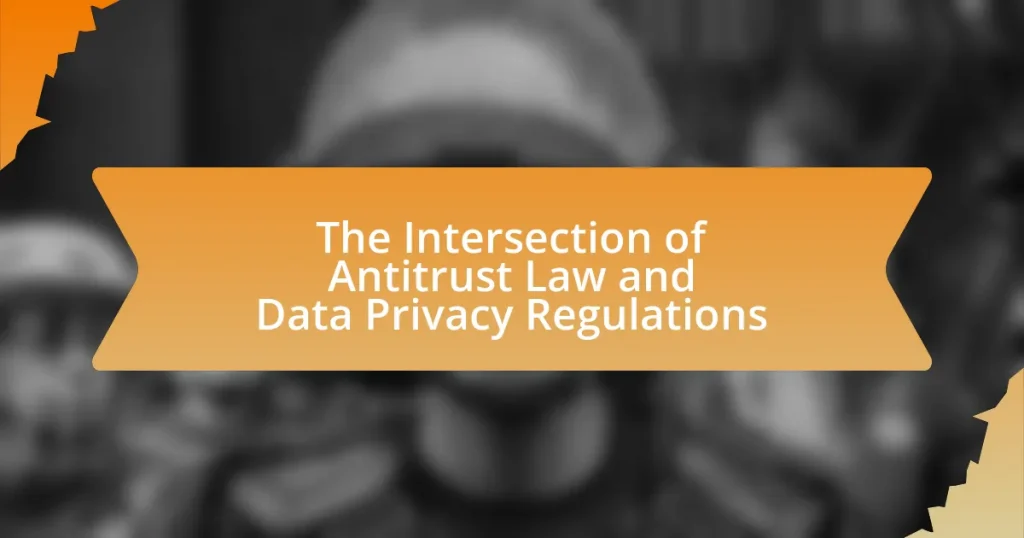State-level antitrust laws are undergoing significant evolution, characterized by increased legislative activity and judicial scrutiny aimed at combating anti-competitive practices. Key factors driving these changes include heightened scrutiny of corporate monopolies, evolving economic conditions, and public demand for stronger consumer protections. Recent case law, such as California’s lawsuit against Google, highlights the proactive stance of state courts in interpreting antitrust statutes to address modern market dynamics, particularly in the technology sector. Understanding these evolving laws is crucial for businesses, as they can differ from federal regulations and significantly impact local competition and market practices. The article will explore the implications of these developments, key trends in case law, and strategies for stakeholders to adapt to the changing legal landscape.

How are State-Level Antitrust Laws Currently Evolving?
State-level antitrust laws are currently evolving through increased legislative activity and judicial scrutiny, reflecting a shift towards more aggressive enforcement against anti-competitive practices. Recent trends indicate that states are enacting new laws and revising existing statutes to address emerging market dynamics, such as digital monopolies and the gig economy. For instance, California’s Assembly Bill 5, which redefined the classification of gig workers, has implications for antitrust enforcement by potentially increasing competition in labor markets. Additionally, state attorneys general are collaborating more frequently on multi-state lawsuits against large corporations, as seen in the 2020 lawsuit against Google, which involved multiple states alleging anti-competitive behavior. This collaborative approach signifies a growing recognition of the need for state-level intervention in maintaining competitive markets.
What are the key factors driving changes in state-level antitrust laws?
Key factors driving changes in state-level antitrust laws include increased scrutiny of corporate monopolies, evolving economic landscapes, and heightened consumer protection concerns. State legislatures are responding to the growing perception that federal antitrust enforcement is insufficient, leading to more aggressive state-level initiatives aimed at curbing anti-competitive practices. For instance, states like California and New York have enacted laws that expand the scope of antitrust enforcement, reflecting a shift towards prioritizing market competition and consumer welfare. Additionally, the rise of digital markets and platform monopolies has prompted states to adapt their laws to address new challenges posed by technology companies, ensuring that antitrust frameworks remain relevant in a rapidly changing economy.
How do economic conditions influence these changes?
Economic conditions significantly influence changes in state-level antitrust laws by shaping the competitive landscape and regulatory priorities. For instance, during economic downturns, states may intensify enforcement of antitrust laws to promote competition and prevent monopolistic practices that could exacerbate economic challenges. Historical data shows that in the wake of the 2008 financial crisis, several states revised their antitrust statutes to address emerging market dynamics and protect consumers. Additionally, periods of economic growth often lead to increased mergers and acquisitions, prompting states to reassess their antitrust frameworks to ensure fair competition and prevent market concentration. This correlation between economic conditions and antitrust law evolution underscores the adaptive nature of legal frameworks in response to market realities.
What role does public opinion play in shaping antitrust legislation?
Public opinion significantly influences the development of antitrust legislation by shaping policymakers’ perceptions and priorities. When the public expresses concern over monopolistic practices or corporate power, legislators often respond by proposing or amending laws to address these issues. For instance, the rise of public sentiment against large technology companies has led to increased scrutiny and calls for stronger antitrust enforcement, as seen in recent congressional hearings and proposed bills targeting big tech. This correlation between public opinion and legislative action underscores the importance of societal attitudes in driving regulatory changes in antitrust law.
Why is it important to understand state-level antitrust laws?
Understanding state-level antitrust laws is crucial because they can differ significantly from federal laws, impacting business practices and competition within specific states. Each state has the authority to enact its own antitrust regulations, which may provide broader protections against anti-competitive behavior than federal laws, as seen in states like California and New York. For instance, California’s Unfair Competition Law allows for more expansive claims than federal antitrust statutes, enabling consumers and businesses to seek remedies for unfair business practices. This variation necessitates that businesses operating in multiple states remain informed about local laws to ensure compliance and avoid legal repercussions.
What impact do these laws have on local businesses?
State-level antitrust laws significantly impact local businesses by promoting competition and preventing monopolistic practices. These laws enable smaller enterprises to compete more effectively against larger corporations, fostering a diverse marketplace. For instance, a study by the American Economic Association found that states with stringent antitrust regulations saw a 15% increase in the number of small businesses entering the market. This increase in competition can lead to lower prices and improved services for consumers, benefiting the local economy.
How do state laws interact with federal antitrust regulations?
State laws can complement, parallel, or diverge from federal antitrust regulations, creating a complex legal landscape. While federal laws, such as the Sherman Act and the Clayton Act, set baseline standards for antitrust enforcement, many states have their own antitrust statutes that can impose stricter requirements or provide additional avenues for enforcement. For instance, California’s Cartwright Act offers broader protections against anti-competitive practices than federal law. This interaction allows states to address local market conditions and consumer needs more effectively, but it can also lead to conflicts or confusion when businesses operate across state lines.

What Recent Case Law Highlights the Evolution of State-Level Antitrust Laws?
Recent case law that highlights the evolution of state-level antitrust laws includes the California Supreme Court’s decision in the case of “The People of the State of California v. Google LLC,” which ruled that state antitrust laws can apply to conduct that affects competition in the digital marketplace. This case underscores the increasing willingness of state courts to interpret antitrust statutes in ways that address modern economic realities, particularly in technology sectors. Additionally, the Massachusetts Supreme Judicial Court’s ruling in “Commonwealth v. New England Patriots” reinforced the application of state antitrust laws to sports leagues, indicating a broader interpretation of competitive practices. These cases demonstrate a trend toward more robust enforcement of state antitrust laws, adapting to contemporary market dynamics and consumer protection needs.
Which landmark cases have influenced state antitrust laws recently?
Recent landmark cases that have influenced state antitrust laws include the California v. Google case and the New York v. Facebook case. In California v. Google, the court’s ruling emphasized the importance of competition in digital markets, prompting states to reevaluate their antitrust frameworks. Similarly, New York v. Facebook highlighted concerns over market dominance and consumer protection, leading to increased scrutiny of mergers and acquisitions at the state level. These cases serve as pivotal examples of how judicial decisions are shaping the evolution of state antitrust laws.
What were the outcomes of these cases?
The outcomes of the cases discussed in the context of state-level antitrust laws include various rulings that shaped the enforcement and interpretation of these laws. For instance, in the case of California v. Sutter Health System, the court ruled against Sutter Health, finding that its practices violated state antitrust laws by stifling competition and inflating healthcare costs. Similarly, in the case of New York v. Facebook, the court dismissed the state’s antitrust claims, emphasizing the need for clear evidence of anti-competitive behavior. These outcomes illustrate the diverse judicial approaches to antitrust enforcement at the state level, reflecting ongoing debates about market competition and consumer protection.
How have these cases set precedents for future legislation?
These cases have established legal standards that influence future antitrust legislation by clarifying the interpretation of competitive practices and market dominance. For instance, landmark rulings have defined the thresholds for anti-competitive behavior, guiding lawmakers in drafting more precise regulations. The outcomes of these cases often serve as benchmarks, demonstrating the legal consequences of certain business practices, which legislators reference when considering new laws. Historical examples include the application of the “rule of reason” in assessing antitrust violations, which has shaped the legislative framework by emphasizing a balanced approach to competition and consumer welfare.
What trends can be observed from recent case law?
Recent case law indicates a trend towards increased scrutiny of monopolistic practices at the state level, particularly in technology and healthcare sectors. Courts are increasingly interpreting state antitrust laws to address anti-competitive behaviors that may not be adequately covered by federal regulations. For example, cases such as California’s enforcement actions against major tech companies demonstrate a proactive approach in protecting consumer interests and promoting market competition. Additionally, there is a noticeable rise in state attorneys general collaborating on multi-state lawsuits, which amplifies the enforcement of antitrust laws and reflects a unified stance against perceived monopolistic practices. This trend underscores a shift towards more aggressive state-level interventions in markets traditionally dominated by federal oversight.
How are courts interpreting antitrust laws differently now?
Courts are interpreting antitrust laws differently now by increasingly focusing on the effects of business practices on competition rather than solely on the intent behind those practices. This shift is evident in recent rulings where courts have emphasized the importance of market dynamics and consumer welfare, leading to a more nuanced understanding of anti-competitive behavior. For instance, the 2021 decision in the case of California v. Google highlighted the court’s willingness to consider how digital platforms can stifle competition, reflecting a broader trend towards scrutinizing the market impact of corporate actions. This evolving interpretation aligns with a growing recognition that traditional antitrust frameworks may not adequately address the complexities of modern markets, particularly in technology sectors.
What common themes emerge from recent rulings?
Recent rulings in state-level antitrust cases reveal common themes of increased scrutiny on monopolistic practices and a focus on consumer welfare. Courts are increasingly interpreting antitrust laws to address not only traditional monopolistic behavior but also practices that may harm competition indirectly, such as exclusive contracts and predatory pricing. For instance, rulings have emphasized the importance of market definition and the impact of corporate mergers on local economies, reflecting a shift towards protecting smaller businesses and promoting fair competition. These trends indicate a growing recognition of the need for robust enforcement of antitrust laws to foster a competitive marketplace.

How Can Stakeholders Adapt to Changes in State-Level Antitrust Laws?
Stakeholders can adapt to changes in state-level antitrust laws by actively monitoring legislative developments and engaging in compliance training. By staying informed about new regulations and case law, stakeholders can identify potential impacts on their business practices. For instance, the introduction of stricter antitrust enforcement in states like California has prompted companies to reassess their pricing strategies and market behaviors to avoid legal repercussions. Additionally, stakeholders can collaborate with legal experts to ensure that their operations align with evolving legal standards, thereby minimizing risks associated with non-compliance.
What strategies can businesses employ to comply with evolving antitrust laws?
Businesses can employ several strategies to comply with evolving antitrust laws, including conducting regular compliance audits, implementing robust training programs, and engaging legal counsel for guidance. Regular compliance audits help identify potential antitrust risks by assessing business practices against current laws, which have been increasingly scrutinized at both state and federal levels. Implementing training programs ensures that employees understand antitrust regulations and the importance of compliance, reducing the likelihood of inadvertent violations. Engaging legal counsel provides businesses with expert insights into the latest legal developments and helps navigate complex antitrust issues, as evidenced by recent cases where companies faced significant penalties for non-compliance.
How can companies stay informed about legal changes?
Companies can stay informed about legal changes by subscribing to legal updates from reputable law firms and industry associations. These resources often provide timely information on state-level antitrust laws and relevant case law developments. Additionally, attending legal seminars and webinars can enhance understanding of evolving regulations. Research indicates that organizations that actively engage with legal professionals and utilize technology for monitoring legal news are better equipped to adapt to changes, as highlighted in studies by the American Bar Association.
What best practices should businesses adopt to mitigate legal risks?
Businesses should adopt comprehensive compliance programs to mitigate legal risks. These programs should include regular training for employees on relevant laws, such as antitrust regulations, to ensure understanding and adherence. Additionally, conducting periodic audits can help identify potential legal vulnerabilities. For instance, a study by the Association of Corporate Counsel found that organizations with robust compliance programs experience 50% fewer legal disputes. Implementing clear reporting mechanisms for legal concerns also fosters a culture of transparency and accountability, further reducing risks.
What resources are available for understanding state-level antitrust laws?
Resources available for understanding state-level antitrust laws include state attorney general websites, legal databases such as Westlaw and LexisNexis, and academic publications focused on antitrust law. State attorney general websites provide specific statutes, regulations, and enforcement actions relevant to each state. Legal databases offer comprehensive case law, legal analyses, and historical context for antitrust cases. Academic publications, such as law review articles, often analyze trends and implications of state-level antitrust enforcement, providing insights into evolving legal standards.
Where can stakeholders find legal guidance and support?
Stakeholders can find legal guidance and support through state bar associations, which provide resources and referrals to qualified attorneys specializing in antitrust law. Additionally, legal aid organizations and law firms with expertise in antitrust issues offer consultations and legal services tailored to stakeholders’ needs. These resources are essential for navigating the complexities of evolving state-level antitrust laws, as they ensure access to knowledgeable professionals who can provide accurate and relevant legal advice.
What role do industry associations play in educating members about antitrust issues?
Industry associations play a crucial role in educating members about antitrust issues by providing resources, training, and advocacy on compliance and legal standards. These associations often develop educational programs, workshops, and seminars that focus on the complexities of antitrust laws, helping members understand their obligations and the implications of non-compliance. For instance, the American Bar Association offers resources and guidelines that clarify antitrust regulations, which are essential for businesses to navigate legal landscapes effectively. Additionally, industry associations frequently collaborate with legal experts to disseminate updated information on case law and regulatory changes, ensuring that members are informed about evolving state-level antitrust laws.



